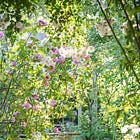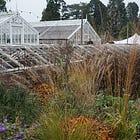Small Garden Design - Week 8: is your garden ‘believable’?
Plus: a final chance to win two tickets to the RHS Chelsea Flower Show, snowdrop walks and a jolly good musical
Small Garden Design
Once you’ve got the ‘journey’ around your garden right, everything else will fall into place. That might sound like quite a brave statement to start off with, but I promise you it’s true. Bear with me:
Have you ever wondered what it is about a successful small garden that makes you want to explore it further? What is it that lures us in and along the garden? We’re talking about magic, mystery, romance here - all those intangibles which are actually created by simply getting things in the right place, and getting a sense of a journey by making sure that all these elements somehow link up. This week, it’s your turn to have a go at creating that all-important flow in your own garden space.
Thank you for supporting The Gardening Mind. For over three years now, you have made it what it is, and each time you like a post by pressing the ❤️, it means that the word spreads. I’m really grateful: as the word spreads, The Gardening Mind reaches a new audience, many of whom are just dipping a toe into the world of gardening for the very first time.
You can absolutely start this small garden design course at any time:
Or you can simply observe - however you feel. You might want to see how this relates to your own space, whatever stage it’s at.
Here’s a round-up of everything we’ve looked at so far here:
Week 1:
Week 2:
Week 3:
Week 4:
Week 5:
Week 6:
You might just be observing out of interest rather than following along - we’d love a ❤️ and to hear your thoughts too!
Before we get onto gardens
The official UK book launch of The New Romantic Garden is on March 11th at the Garden Museum, where I’ll be in conversation with Rachel de Thame. If you’d like to join us at this Garden Museum event, tickets are available here. There’s a waitlist but we’re working on a way to release more tickets so do join the list just in case. I’d LOVE to see you there.
I have reserved two tickets for Gardening Mind Gold Members, so if you have Gold Membership, just DM me and let me know you’d like your name to go into the draw for this event:
I’m also at the V&A on 25th March with Jo Fairley, and on Thursday 6th March, I’ll be joining Xa Tollemache in a lovely day of talking about gardens - we’ll be at Rodmarton Manor in Cirencester, UK. You can book tickets at The Generous Gardener page here.
For US members: on Thursday May 1st I’ll be speaking at The Garden Symposium held in the beautiful grounds of Andalusia Historic House, Gardens & Arboretum. Early bird tickets are available here.
The whole process of making a book is a strange old thing: you spend years thinking about it, a year or so writing it, a few months playing about with it as it's being edited. Then it disappears and gestates for 6 months somewhere between the publishers and printers. At that point you think it's all ridiculous - what on earth were you thinking / what a lot of nonsense / you should have included this / shouldn't have written that etc etc etc.
And then the book arrives and you dare yourself to look at it, gradually being brave enough to open your scrunched-up eyes. And then you have to wait and see if anyone likes it...... That’s why those early pre-orders and reviews mean so much. A huge thank you to you if you’ve already ordered it.
RHS Chelsea Flower Show - news
I can’t give you any PRECISE updates at the moment on RHS Chelsea Flower Show but I’ll be sharing any news first here on The Gardening Mind: let’s just say I now remember why I said I’d never do Chelsea again. We’ve calculated that as a studio we’ve already spent 350 days on the whole project - that’s around 1.5 ‘man years’ - ie working years. It’s a lot, I know. And we’re just in February: the next three months will be rammed.
You might be wondering where all that time and energy go. I’ve realised much of it is about bringing to life those mind-details that will make this garden stay in the visitor’s mind. And to bring to life mind-details, you need mind-readers and communicators. I think we’ve definitely got that in our team and I’m looking forward to sharing more:
There’s the elusive rose that I spotted in a garden in Venice and how I identified it and then tracked down the one supplier in Europe.
There’s the detail that I spotted in a garden in Wiltshire, which I desperately want to recreate, but which needs decades of time to make it work - will we pull it off?
There’s the furniture I had seen decades ago in a country garden, and had just a snapshot of it in my mind. We spent days, whole days, scouring the internet for images which matched this mind-detail, but had no luck and decided to compromise using something similar. But then one day before Christmas, my daughter, an interior designer, showed me an image of a chair that she had seen and loved. There it was, that elusive garden chair, whose makers turned out to be just a couple of hours away from Venice. That’s where I was last week.
There’s a meeting with some incredible women who work in the justice system, who have been brought together by a desire to support The Glasshouse garden at Chelsea.
I can’t wait to show you more. I can’t wait to get on that muddy site and start building.
Ticket opportunity
If you’re a Gold Member of The Gardening Mind, your name will have gone into the hat for the chance to receive two show tickets to come and spend some time on my garden with me at the RHS Chelsea Flower Show in May. You still have a chance to get your name in the hat.
Back in December, we discussed the concept of zoning the garden and working out where to position all the things on your wish-list of garden areas (play, dining, veg growing etc). I’m hoping by now that you’ll have decided where everything is going to go.
By zoning, I mean areas for plants/ areas for humans. In the widest sense of zoning, ‘planting’ is in itself a zone. Think about your needs, and then ‘zone’ them. It might be as simple as this:
Plants, table, storage.
It could have more zones:
Plants, dining table, play, shed, compost, reading spot.
Most importantly, remember that the very best place in your garden goes to YOU. That sunny or shady spot you’re drawn to - that’s for you, your bench/chair/table, whatever it is that will make your place a happy garden place. Remember storage does not go in the best place. It goes in that terrible dark, shady, dry or dank place that you never want to visit.
Now we’re moving on with the idea of the flow around the garden, that journey from spot to spot that makes the whole experience of looking at and travelling round your garden an interesting/exciting/magical one. And yes, there absolutely can be a journey round the tiniest of spaces, where it might be a visual journey rather than a physical one, but the journey is key to the magic. I keep talking about magic, and I realised, when I dared to revisit The New Romantic Garden after all these months of waiting, that there’s a lot about magic in there too. How garden magic works, how we can grasp it and use it to create a garden which is all about you and the place combined. It IS possible.
This week’s task is for you to make a decision on how you join up your garden areas, and I’ve got a case-study to help you.
First of all, what was here beforehand?
As you can see, not very much at all. This photo above was taken from the pavement, so there are cars and people behind me. On first sight, there’s nothing very prepossessing here. I’m looking at a pile of rubble, a car, and some neighbouring houses.
But look again. Look at the architecture to the left, the building in the distance. We’ve got things to celebrate here. Old brick walls, the former telephone exchange of the village with its little sentry box phone room just protruding out. There is definitely a way to make this space into a garden that feels right.
I talk a lot in The New Romantic Garden about things feeling right: for a garden to have that magic, it needs to fit where it is. We don’t need eye-wateringly contemporary elements in the middle of Sissinghurst village where this garden sits. Then again, we don’t want to make a pastiche of a seventeenth century garden either. Always bear in mind what we’ve talked about regarding Design for Design’s Sake: eg do we really need those roof-trained pleached trees. or plank paving in a village or rural location? They may mark your garden out as somewhere where we’ve tried a bit too hard. And as soon as there’s an element of suspicion, the garden loses its magic. We want to feel relaxed, at one with the space. Nothing jarring.
Here’s the site analysis: the photo was taken from the spot on the plan where it says ‘location of pavement offers no privacy’:
The brief from the clients was clear: this garden needed to be a place to hold three pieces of art that were very special to them. It also needed to have abundant planting, no lawn, a place for grandchildren to ride their tricycles, a place to eat. Added to which, the whole thing had to be notionally but not heavily divided from the garden of the neighbouring attached house, which was rented out.
This was a garden, overlooked by neighbouring houses and visible from the street, which had to be in conversation with the starkly contemporary interior of this restored sixteenth-century bakery (home to an artist and gallery-owner) as well as with the vernacular architecture on all sides.
The overlooked aspect immediately suggested one over-arching necessity that absolutely had to be dealt with:



















